Excede Sterile Suspension
This treatment applies to the following species: Company: Zoetis
Company: Zoetis
(Ceftiofur Crystalline Free Acid)
Sterile Suspension
For subcutaneous injection in the posterior aspect of the ear where it attaches to the head (base of the ear) in lactating dairy cattle. For subcutaneous injection in the middle third of the posterior aspect of the ear or in the posterior aspect of the ear where it attaches to the head (base of the ear) in beef and non-lactating dairy cattle. Not for use in calves to be processed for veal.
Excede Sterile Suspension Caution
Federal (USA) law restricts this drug to use by or on the order of a licensed veterinarian. Federal law prohibits extra-label use of this drug in cattle for disease prevention purposes; at unapproved doses, frequencies, durations, or routes of administration; and in unapproved major food producing species/production classes.
Description
EXCEDE Sterile Suspension is a ready-to-use formulation that contains the crystalline free acid of ceftiofur, which is a broad spectrum cephalosporin antibiotic active against Gram-positive and Gram-negative bacteria including β-lactamase-producing strains. Like other cephalosporins, ceftiofur is bactericidal, in vitro, resulting from inhibition of cell wall synthesis.
Each mL of this ready-to-use sterile suspension contains ceftiofur crystalline free acid equivalent to 200 mg ceftiofur, in a caprylic/capric triglyceride and cottonseed oil based suspension.
Figure 1. Structure of ceftiofur crystalline free acid:
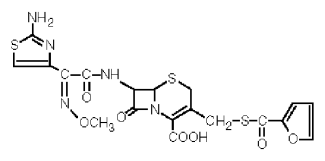
Chemical name of ceftiofur crystalline free acid:
7-[[2-(2-Amino-4-thiazolyl)-2-(methoxyimino)acetyl]amino]- 3-[[(2-furanylcarbonyl) thio] methyl]-8-oxo-5-thia-1- azabicyclo[4.2.0]oct-2-ene 2-carboxylic acid
Excede Sterile Suspension Indications
EXCEDE Sterile Suspension is indicated for treatment of bovine respiratory disease (BRD, shipping fever, pneumonia) associated with Mannheimia haemolytica, Pasteurella multocida, and Histophilus somni in beef, non-lactating dairy, and lactating dairy cattle.
EXCEDE Sterile Suspension is also indicated for the control of respiratory disease in beef and non-lactating dairy cattle which are at high risk of developing BRD associated with M. haemolytica, P. multocida, and H. somni.
EXCEDE Sterile Suspension is also indicated for the treatment of bovine foot rot (interdigital necrobacillosis) associated with Fusobacterium necrophorum and Porphyromonas levii in beef, non-lactating dairy, and lactating dairy cattle.
EXCEDE Sterile Suspension is also indicated for treatment of acute metritis (0-10 days post-partum) associated with bacterial organisms susceptible to ceftiofur in lactating dairy cattle.
Dosage
Treatment of BRD and bovine foot rot
Administer as a single subcutaneous injection in the posterior aspect of the ear where it attaches to the head (base of the ear) to cattle at a dosage of 3.0 mg ceftiofur equivalents (CE)/lb (6.6 mg CE/kg) body weight (BW) (1.5 mL sterile suspension per 100 lb BW).
In beef and non-lactating dairy cattle, EXCEDE Sterile Suspension may also be administered as a single subcutaneous injection in the middle third of the posterior aspect of the ear at a dosage of 3.0 mg CE/lb (6.6 mg CE/kg) BW (1.5 mL sterile suspension per 100 lb BW).
Most animals will respond to treatment within three to five days. If no improvement is observed, the diagnosis should be reevaluated.
Control of BRD
Administer as a subcutaneous injection either in the middle third of the posterior aspect of the ear or in the posterior aspect of the ear where it attaches to the head (base of the ear) to beef and non-lactating dairy cattle at a dosage of 3.0 mg CE/lb (6.6 mg CE/kg) BW (1.5 mL sterile suspension per 100 lb BW).
Clinical studies indicate that administration of EXCEDE Sterile Suspension is effective for the control of respiratory disease in beef and non-lactating dairy cattle at “high risk” of developing BRD. One or more of the following factors typically characterizes calves on arrival at high risk of developing BRD.
● Cattle are from multiple farm origins,
● cattle have had extended transport times (that may have included few if any rest stops),
● ambient temperature change from origin to arrival of 30° F or more,
● cattle have had continued exposure to extremely wet or cold weather conditions,
● cattle have experienced excessive shrink or excessive arrival processing procedures (such as castration, dehorning).
Treatment of Acute Metritis
Administer as a subcutaneous injection in the posterior aspect of the ear where it attaches to the head (base of the ear) to lactating dairy cattle at a dosage of 3.0 mg CE/lb (6.6 mg CE/kg) BW (1.5 mL sterile suspension per 100 lb BW). Repeat this dose in the contra-lateral (opposite) ear approximately 72 hours following the initial dose.
Table 1. Dosing Schedule for EXCEDE Sterile Suspension.
|
Weight (lb) |
Dose Volume (mL) |
|
100 |
1.5 |
|
200 |
3.0 |
|
300 |
4.5 |
|
400 |
6.0 |
|
500 |
7.5 |
|
600 |
9.0 |
|
700 |
10.5 |
|
800 |
12.0 |
|
900 |
13.5 |
|
1000 |
15.0 |
|
1100 |
16.5 |
|
1200 |
18.0 |
|
1300 |
19.5 |
|
1400 |
21.0 |
|
1500 |
22.5 |
|
1600 |
24.0 |
|
1700 |
25.5 |
|
1800 |
27.0 |
|
1900 |
28.5 |
|
2000 |
30.0 |
Administration
ADMINISTRATION FOR THE MIDDLE THIRD OF THE EAR
● Shake well before using. Please read the complete package insert before administering EXCEDE Sterile Suspension subcutaneously in the posterior ear of cattle.
● Deposit as a single subcutaneous injection in the middle third of the posterior aspect of the ear, avoiding all blood vessels. See Figures 2 and 3.
● Adjust the needle insertion point to avoid any blood vessels, previous implants, ear tags or ear tag holes. Do not administer intra-arterially.
● Deliver the entire contents of the syringe.
● When administered correctly, a subcutaneous bleb of EXCEDE Sterile Suspension will appear.
● When withdrawing the needle, apply pressure to the needle insertion point, and massage toward the base of the ear.
Figure 2. Subcutaneous administration of EXCEDE Sterile Suspension in the middle third of the posterior aspect of the ear.
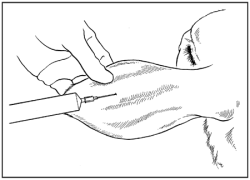
Figure 3. Diagram of the approximate locations of the major arteries of the posterior ear and the recommended needle insertion locations. Administration of EXCEDE Sterile Suspension into ear arteries is likely to be fatal.
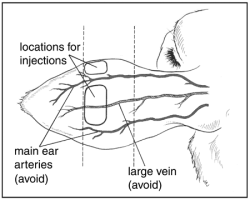
Administration For The Base Of The Ear
In lactating dairy cattle the injection techniques for subcutaneous (SC) injection in the posterior aspect of the ear where it attaches to the head (base of the ear) can be made by the rostral or ventral injection techniques.
In beef and non-lactating dairy cattle the SC injection in the base of the ear can be made by the rostral, ventral or toward the opposite eye injection techniques.
● Shake well before using. Please read the complete package insert before administering EXCEDE Sterile Suspension subcutaneously in the posterior aspect of the ear where it attaches to the head (base of the ear).
● The subcutaneous (SC) injection may be made using the toward the opposite eye, rostral, or ventral techniques. Hold the syringe and needle and insert the needle as described below.
● Deliver the entire contents of the syringe.
● Do not administer EXCEDE Sterile Suspension in the neck.
Administration for the Base of the Ear: Toward the Opposite Eye Technique
● Hold the syringe and needle behind the ear to be dosed so the needle and syringe point in the direction of an imaginary line that would pass through the head toward the animal’s opposite eye. See Figures 4 and 5.
● Insert the needle through the loose skin in the posterior aspect of the ear where it attaches to the head (base of the ear) while maintaining this angle. See Figure 4.
Figure 4. Subcutaneous administration of EXCEDE Sterile Suspension in the posterior aspect of the ear where it attaches to the head (base of the ear).
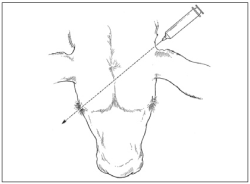
Figure 5. Injection location for the subcutaneous administration of EXCEDE Sterile Suspension in the posterior aspect of the ear where it attaches to the head (base of the ear).
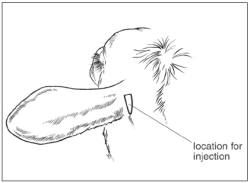
Administration for the Base of Ear: Toward the Same Eye Technique or Rostral Direction
● Hold the syringe and needle behind the ear to be dosed so the needle and syringe point in the direction of an imaginary line that would pass through the head toward the eye on the same side of the head. See Figures 5 and 6.
● Insert the needle through the loose skin in the posterior aspect of the ear where it attaches to the head (base of the ear) while maintaining the needle position. See Figure 6.
Figure 6. Diagram of head showing the direction for the base of ear injections administered rostrally toward the eye on the same side of the head into the loose skin in the caudal aspect of the base of the ear.
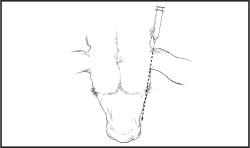
Administration for Base of the Ear: Ventral Technique
● Hold the syringe and needle above the ear to be dosed so that the needle and syringe are pointing ventrally toward the base of the ear. The needle will be inserted into the loose skin in the posterior aspect of the ear where it attaches to the head (base of the ear) while pointing ventrally. Care should be taken to not insert the needle through the cartilage of the ear. See Figure 7.
● Insert the needle through the loose skin in the posterior aspect of the ear where it attaches to the head (base of the ear) while maintaining needle position. See Figure 7.
Figure 7. Diagram of head showing the direction of base of ear injections when administered ventrally into the loose skin in the caudal aspect of the base of the ear.
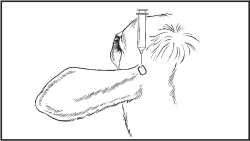
Contraindications
As with all drugs, the use of EXCEDE Sterile Suspension is contraindicated in animals previously found to be hypersensitive to the drug.
Warnings
FOR USE IN ANIMALS ONLY. NOT FOR HUMAN USE.
KEEP OUT OF REACH OF CHILDREN.
Penicillins and cephalosporins can cause allergic reactions in sensitized individuals. Topical exposures to such antimicrobials, including ceftiofur, may elicit mild to severe allergic reactions in some individuals. Repeated or prolonged exposure may lead to sensitization. Avoid direct contact of the product with the skin, eyes, mouth and clothing. Sensitization of the skin may be avoided by wearing protective gloves.
Persons with a known hypersensitivity to penicillin or cephalosporins should avoid exposure to this product.
In case of accidental eye exposure, flush with water for 15 minutes. In case of accidental skin exposure, wash with soap and water. Remove contaminated clothing. If allergic reaction occurs (e.g., skin rash, hives, difficult breathing), seek medical attention.
The material safety data sheet contains more detailed occupational safety information. To obtain a material safety data sheet or to report any adverse event please call 1-888-963-8471.
Intra-arterial injection may occur during administration of EXCEDE Sterile Suspension via middle third of the ear injection or base of the ear injection directed towards the opposite eye. Intra-arterial injection of EXCEDE Sterile Suspension is likely to result in sudden death of the animal.
 |
RESIDUE WARNINGS ● Following label use as either a single-dose or 2-dose regimen, a 13-day pre-slaughter withdrawal period is required after the last treatment. ● Following label use as either a single-dose or 2-dose regimen, no milk discard period is required for this product. ● Use of dosages in excess of 3.0 mg CE/lb (6.6 mg CE/kg) BW or administration by unapproved routes (subcutaneous injection in the neck or intramuscular injection) may cause violative residues. ● A withdrawal period has not been established for this product in preruminating calves. ● Do not use in calves to be processed for veal. |
 |
Antibacterial Warnings
Use of antibacterial drugs in the absence of a susceptible bacterial infection is unlikely to provide benefit to treated animals and may increase the risk of the development of drug-resistant bacteria.
Precautions
Following subcutaneous injection in the middle third of the posterior aspect of the ear, thickening and swelling (characterized by aseptic cellular infiltrate) of the ear may occur. As with other parenteral injections, localized post-injection bacterial infections may result in abscess formation. Attention to hygienic procedures can minimize their occurrence.
Following injection in the posterior aspect of the ear where it attaches to the head (base of the ear), areas of discoloration and signs of inflammation may persist at least 13 days post administration resulting in trim loss of edible tissue at slaughter. Injection of volumes greater than 20 mL, in the middle third of the ear, may result in open draining lesions in a small percentage of cattle.
The effects of ceftiofur on bovine reproductive performance, pregnancy, and lactation have not been determined.
Adverse Effects
Intra-arterial injection may occur during administration of EXCEDE Sterile Suspension via middle third of the ear injection or base of the ear injection directed towards the opposite eye. Intra-arterial injection of EXCEDE Sterile Suspension is likely to result in sudden death of the animal. During the conduct of clinical studies, there was a low incidence of acute death (see ANIMAL SAFETY) confirmed to be the result of inadvertent intra-arterial injection. No other adverse systemic effects were noted for either the antibiotic or formulation during any of the clinical and target animal safety studies.
Clinical Pharmacology
Ceftiofur administered as either ceftiofur sodium (NAXCEL® Sterile Powder), ceftiofur hydrochloride (EXCENEL® RTU Sterile Suspension), or ceftiofur crystalline free acid (EXCEDE Sterile Suspension) is metabolized rapidly to desfuroylceftiofur, the primary metabolite. Subcutaneous administration of ceftiofur crystalline free acid, either in the middle third of the posterior aspect of the ear (middle third of the ear, MOE) of beef and non-lactating dairy cattle, or in the posterior aspect of the ear where it attaches to the head (base of the ear, BOE) of beef, non-lactating dairy, and lactating dairy cattle, provides therapeutic concentrations of ceftiofur and desfuroylceftiofur-related metabolites in plasma above the lowest minimum inhibitory concentration to encompass 90% of the most susceptible isolates (MIC90) for the labeled BRD pathogens, Pasteurella multocida, Mannheimia haemolytica and Histophilus somni, for generally not less than 150 hours after a single administration (See Figure 8).
Single Dose Regimen
The pharmacokinetic parameters for the two subcutaneous locations of injection (MOE and BOE) are found in Table 2. Statistical analyses of the data from these two subcutaneous injection sites (MOE and BOE) demonstrate that they are therapeutically equivalent.
Figure 8. Average (n=12/group) plasma concentrations of ceftiofur and desfuroylceftiofur-related metabolites after administration of EXCEDE Sterile Suspension at 3.0 mg CE/lb (6.6 mg CE/kg) BW via subcutaneous injection into one of two different locations of the ear, middle third of the ear (MOE Cattle) and base of the ear (BOE Cattle) in beef cattle as well into the base of the ear (BOE Lactating) in lactating dairy cattle.
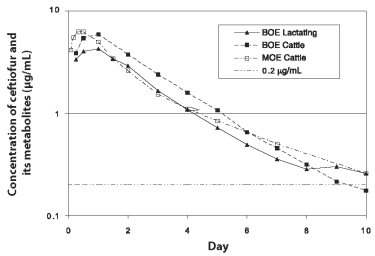
Table 2. Average (n = 12/group) pharmacokinetic parameters for ceftiofur and desfuroylceftiofur metabolites calculated after a single subcutaneous administration of 3.0 mg CE/lb (6.6 mg CE/kg) BW of EXCEDE Sterile Suspension in either the middle third of the ear or the base of the ear.
|
Pharmacokinetic Parameter |
Beef - Middle Third of the Ear Mean Value ± Standard Deviation |
Beef - Base of the Ear Mean Value ± Standard Deviation |
Dairy Cow - Base of the Ear Mean Value ± Standard Deviation |
|
Cmax (µg CE/mL) |
6.90 ± 2.68 |
6.39 ± 1.79 |
4.44 ± 1.65 |
|
tmax (h) |
12.0 ± 6.2 |
19.8 ± 5.81 |
19.00 ± 8.02 |
|
AUC 0-LOQ (µg•h/mL) |
376 ± 66.1 |
412 ± 67.3 |
313 ± 85.5 |
|
t>0.2, model (h) |
183 ± 40.8 |
NE |
NE |
|
t>0.2, nca (h) |
246 ± 48.5 |
218 ± 45.5 |
205 ± 35.7 |
|
t1/2 (h) |
62.3 ± 13.5 |
40.7 ± 11.2 |
43.92 ± 9.84 |
Cmax (µg CE/mL) = maximum plasma concentration (in µg CE/mL).
tmax (h) = the time after injection when Cmax occurs (in hours).
AUC 0-LOQ (µg•h/mL) = the area under the plasma concentration vs. time curve from time of injection to the limit of quantitation of the assay (0.15 µg CE/mL).
t>0.2, model (h) = the time plasma concentrations remain above 0.2 µg CE/mL (in hours), estimated using compartmental pharmacokinetic techniques.
t>0.2, nca (h) = the time plasma concentrations remain above 0.2 µg CE/mL (in hours), estimated using noncompartmental pharmacokinetic techniques.
t1/2 (h) = terminal phase biological half life (in hours)
NE + Not estimated
Two-Dose Regimen
A two-dose regimen of 6.6 mg CE/kg BW administered 72 hours apart is required for the treatment of acute metritis in lactating cows. The mean plasma concentration vs. time profile for ceftiofur and desfuroylceftiofur-related metabolites for the 2-dose regimen in 12 cows is shown in Figure 9 below. The pharmacokinetic parameters for the 2-dose regimen are provided in Table 3.
Figure 9. LS-Mean DCA Plasma Concentration Time Profile Following Two Subcutaneous Injections of EXCEDE 72 hours apart at a Dose of 3.0 mg CE/lb (6.6 mg CE/kg) BW in 12 lactating cows.
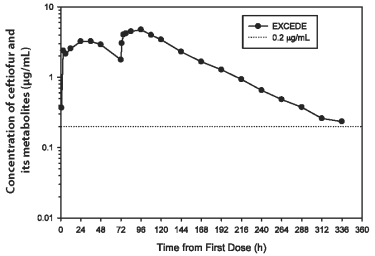
Table 3. Average (n = 12) Pharmacokinetic Parameters Following Two Subcutaneous Injections of EXCEDE Sterile Suspension at a Dose 3.0 mg CE/lb (6.6 mg CE/kg) BW at a 72 Hour Interval.
|
PK Parameter |
Mean ± Standard Deviation |
|
AUC0-LOQ (µg•h/mL) |
651 ± 119 |
|
t1/2 (h) |
55.7 ± 4.84 |
|
t>0.2 (h) |
341 ± 34.0 |
|
Tmax (h) |
77.1 ± 33.4 |
|
Cmax (µg/mL) |
5.98 ± 2.51 |
Microbiology
Ceftiofur has demonstrated in vitro activity against Mannheimia haemolytica, Pasteurella multocida, and Histophilus somni, three major pathogens associated with BRD, and against Fusobacterium necrophorum and Porphyromonas levii associated with bovine foot rot.
A summary of the susceptibility of BRD and foot rot pathogens is presented in Table 4. BRD isolates were obtained from cattle enrolled in a field study conducted in the United States that were diagnosed with BRD. Foot rot isolates were obtained from cattle enrolled in a field study conducted in the United States and Canada that were diagnosed with foot rot. Susceptibility testing was conducted according to the Clinical and Laboratory Standards Institute (CLSI) M7-A3 and M11-A6 standards for BRD and foot rot isolates, respectively.
Table 4. Ceftiofur minimum inhibitory concentration (MIC) values* of indicated pathogens isolated from cattle with naturally occurring BRD or foot rot.
|
Indicated pathogen |
Year of isolated |
Number of isolates |
MIC50** (µg/mL) |
MIC90** (µg/mL) |
MIC range (µg/mL) |
|
Mannheimia haemolytica |
1996 to 1997 |
75 |
0.008 |
0.015 |
0.001 to 0.015 |
|
Pasteurella multocida |
1996 to 1997 |
43 |
0.004 |
0.004 |
0.001 to 0.015 |
|
Histophilus somni |
1996 to 1997 |
11 |
0.004 |
0.004 |
0.002 to 0.015 |
|
Fusobacterium necrophorum |
2006 to 2007 |
148 |
≤ 0.25 |
0.5 |
≤ 0.25 to > 128 |
|
Porphyromonas levii |
2006 to 2007 |
141 |
≤ 0.25 |
2.0 |
≤ 0.25 to 16 |
* The correlation between in vitro susceptibility data and clinical effectiveness is unknown.
** The lowest MIC to encompass 50% and 90% of the most susceptible isolates, respectively.
Based on pharmacokinetic and clinical effectiveness studies of ceftiofur in cattle after a single administration of 3.0 mg CE/lb (6.6 mg CE/kg) BW and the MIC and susceptibility data, the following breakpoints are recommended for BRD pathogens by CLSI.
Table 5. CLSI-accepted interpretive criteria* for ceftiofur against cattle respiratory pathogens.
|
Pathogen |
Disk potency |
Zone diameter (mm) |
MIC breakpoint (µg/mL) |
||||
|
|
|
S |
I |
R |
S |
I |
R |
|
Mannheimia haemolytica |
30 µg |
≥ 21 |
18 to 20 |
≤ 17 |
≤ 2.0 |
4.0 |
≥ 8.0 |
|
Pasteurella multocida |
|||||||
|
Histophilus somni |
|||||||
|
S - Susceptible I - Intermediate R - Resistant |
|
|
|
|
|
|
|
* These interpretive criteria are only intended for use when CLSI M31-A2 performance standards are used to determine antimicrobial susceptibility. Interpretive criteria for bovine foot rot pathogens have not been established.
Effectiveness
A field dose confirmation study for the treatment of BRD evaluated the effectiveness of single doses of 2.0 and 3.0 mg CE/lb (4.4 or 6.6 mg CE/kg) BW for the treatment of the bacterial component of BRD under field conditions. All treatments were administered subcutaneously in the middle third of the posterior aspect of the ear. Cattle were clinically evaluated on Days 2 to 4, 14 and 28 and were observed on all other study days. The 3.0 mg CE/lb (6.6 mg CE/kg) BW EXCEDE Sterile Suspension dose significantly (p≤0.05) increased Day 14 treatment success rate, defined as animals that did not require any ancillary treatment and had a rectal temperature of <104°F, normal respiration index, and had no or mild depression on that day.
The effectiveness of a single dose of EXCEDE Sterile Suspension for the control of BRD in feedlot cattle was evaluated in a nine-location field effectiveness study. In addition to standard processing on arrival at feedlots, cattle (n=3911) considered to be at high risk for BRD were assigned to one of four arrival treatments, including EXCEDE Sterile Suspension at 2.0 or 3.0 mg CE/lb (4.4 or 6.6 mg CE/kg) BW or negative control. Effectiveness evaluation was based on the incidence of clinical BRD within 28 days following arrival processing. Administration of a single dose of EXCEDE Sterile Suspension administered subcutaneously in the middle third of the posterior aspect of the ear at arrival processing significantly reduced the incidence of BRD in high-risk feedlot cattle in the 28-day period after arrival processing compared to negative controls.
Base of the ear administration (beef and non-lactating dairy cattle) and middle third of the ear administration (lactating dairy cattle) were compared to the middle third of the ear pharmacokinetic data for beef and non-lactating dairy cattle and were found to be therapeutically equivalent.
The effectiveness of EXCEDE Sterile Suspension for the treatment of bovine foot rot was evaluated in a six-location field effectiveness study. Cattle diagnosed with bovine foot rot were enrolled and treated with EXCEDE Sterile Suspension, administered by subcutaneous injection in the base of the ear as a single dose of 3.0 mg CE/lb (6.6 mg CE/kg) BW or an equivalent volume of a vehicle control. Cattle were clinically evaluated 7 days post-treatment for treatment success, which was based on defined decreases in lesion, swelling and lameness scores. A total of 169 beef and dairy cattle were included in the analysis. There was a statistically significant difference (p = 0.0054) in treatment success for EXCEDE-treated cattle (58.4%) compared to vehicle-treated control cattle (13.2%).
The effectiveness of EXCEDE Sterile Suspension for the treatment of acute metritis was evaluated in a 15-location field effectiveness study. A total of 1023 cows with a fetid vaginal discharge and a rectal temperature of ≥ 103 °F were enrolled in the study and treated with either a two-dose regimen of EXCEDE (6.6 mg CE/BW) or an equivalent volume of vehicle control, administered approximately 72 hours apart at the base of opposite ears. At 14 days post-treatment, each cow remaining in the study was examined and rectal temperature and vaginal discharge score were recorded. Cows with a non-fetid discharge, and a rectal temperature < 103 °F, and that did not require alternate (“escape”) therapy during the 14-day observation period were classified as a cure. The cure rate was significantly higher (p < 0.0001) in EXCEDE-treated cows (362/493, 74.3%) than in vehicle-treated cows (271/489, 55.3%). One cow died 15 to 20 minutes after the second administration of EXCEDE. Necropsy findings determined the probable cause of death to be intra-arterial injection.
Animal Safety
Systemic Safety Studies
After parenteral administration, ceftiofur crystalline free acid (as EXCEDE Sterile Suspension), ceftiofur sodium and ceftiofur hydrochloride are rapidly metabolized to desfuroylceftiofur. Therefore, studies conducted with ceftiofur sodium are adequate to evaluate the systemic safety of EXCEDE Sterile Suspension. Results from a five-day tolerance study conducted with ceftiofur sodium in normal feeder calves indicated that ceftiofur was well tolerated at 25 mg CE/lb/day for five consecutive days, approximately 8 times the approved dose of EXCEDE Sterile Suspension 3.0 mg CE/lb (6.6 mg CE/kg) BW. Ceftiofur administered parenterally had no adverse systemic effects.
In a 15-day safety/toxicity study, five steer and five heifer calves per group were administered ceftiofur sodium intramuscularly at 0 (vehicle control), 1, 3, 5 or 10 mg CE/lb/day thus, evaluating up to 3.3 times the approved dose of EXCEDE Sterile Suspension of 3.0 mg CE/lb/day (6.6 mg CE/kg) BW. There were no adverse systemic effects, indicating that ceftiofur has a wide margin of safety when injected intramuscularly into feeder calves. Local tissue tolerance to subcutaneous injection of EXCEDE Sterile Suspension in the posterior ear of cattle was evaluated in a separate study.
The systemic safety of ceftiofur concentrations resulting from product administration at the base of the ear was established via a pharmacokinetic comparison of the two routes of administration (base of the ear versus middle third of the ear). Based upon the results of this relative bioavailability study, it was determined that the two routes of administration are therapeutically equivalent.
To support systemic target animal safety for the 2-dose metritis regimen, five projected daily doses of NAXCEL Sterile Powder (ceftiofur sodium) at 2.2 mg/kg BW were compared pharmacokinetically with EXCEDE administered 2 times at a 72 hour interval at 6.6 mg/kg BW. The peak concentration (Cmax) and the extent of exposure (AUC) after two doses of EXCEDE were statistically no higher than the exposure following five daily doses of NAXCEL Sterile Powder in beef cattle.
Investigation Of Intra-arterial And Intravenous Injection
In approximately 6000 animals enrolled in the BRD clinical studies, nine animals died following injection of EXCEDE Sterile Suspension. All deaths were within 30 minutes of the time of injection. The exact cause was confirmed in three animals. These deaths resulted from inadvertent intra-arterial injection of this oil-based suspension into one of the two major auricular (ear) arteries. Intra-arterial injection at this location resulted in direct administration of the oil-based formulation into the arterial blood supply of the brain resulting in embolism and death.
Since intra-arterial injection was confirmed in three animals that died following injection of EXCEDE Sterile Suspension, the consequences of purposeful intra-arterial injection of EXCEDE Sterile Suspension were investigated in feeder cattle. Two heifers (body weight approximately 225 kg) were given a single 3.0 mg CE/lb (6.6 mg CE/kg) BW bolus dose of EXCEDE Sterile Suspension in the middle auricular artery. Both heifers collapsed immediately and died within approximately eight minutes of injection. Intra-arterial injection of EXCEDE Sterile Suspension in the ear will result in death and must be avoided.
Since subcutaneous injection in the ear may potentially result in inadvertent intravenous administration of an injectable product, the consequences of purposeful intravenous injection of EXCEDE Sterile Suspension were investigated in feeder cattle. Three heifers and three steers (body weight range 197-223 kg) were given a single 3.0 mg CE/lb (6.6 mg CE/kg) BW bolus dose of EXCEDE Sterile Suspension in the jugular vein and were monitored for adverse effects following injection. One steer and one heifer had transient (2 to 5 minutes) increases in heart rate without any other untoward signs in these or the other cattle. Intravenous injection of EXCEDE Sterile Suspension is an unacceptable route of administration.
Safety Studies In Beef Cattle
Middle of the ear injection:
A study was designed and conducted to specifically address tissue tolerance in cattle when EXCEDE Sterile Suspension was administered as a single subcutaneous injection into the posterior aspect of the ear of cattle at the recommended dose of 3.0 mg CE/lb (6.6 mg CE/kg) BW. Results from this study indicate that the subcutaneous injection of EXCEDE Sterile Suspension into the middle third of the posterior aspect of the ear of cattle is well tolerated and characterized by a biphasic thickening of the ear. The initial increase in thickness is attributed to the space required for the volume of injected material. Additional increases in thickness were observed through Day 14 after injection. After Day 14, post injection ear thickness decreased in all animals. One animal carried an injected ear in a drooping position for 7 days post injection. At necropsy, subcutaneous areas of discoloration and some foci of hemorrhage were observed in ears of injected cattle. The discoloration was markedly reduced in size by the end of the study. Ears are inedible tissues in the US (9 CFR 301.2). No signs of irritation were observed on the edible portions of the carcass around the base of the ear.
The local tolerance of the ear of cattle to a single subcutaneous injection of EXCEDE Sterile Suspension was also evaluated in a large multi-location effectiveness study. None of the 1927 animals treated with EXCEDE Sterile Suspension were removed from this trial due to ear irritation although swelling was noted at some injection sites. Leak back and/or bleeding from the injection site was observed in a small fraction of the treated animals immediately after administration. It was concluded that administration of EXCEDE Sterile Suspension in the posterior aspect of the ear was well tolerated and was acceptable under feedlot conditions.
A study evaluated the 56-day feedlot performance of beef steers administered EXCEDE Sterile Suspension alone, EXCEDE Sterile Suspension with a growth promoting implant, growth promoting implant alone, or neither product, in a total of 207 Angus and Angus cross-bred steers. The administration of EXCEDE Sterile Suspension in the posterior aspect of the ear with or without growth promoting implants was well tolerated by cattle and did not adversely affect feedlot cattle performance. Based upon the results of this study, the location of implants administered after EXCEDE Sterile Suspension may need to be adjusted slightly within the boundaries of the middle third of the ear in some animals.
Base of the ear injection:
The local tolerance of the ear to a single subcutaneous injection at the base of the ear of EXCEDE Sterile Suspension was evaluated in a multi-location field study in 2926 beef cattle. Normal restraint was adequate for administration of EXCEDE Sterile Suspension for 99.8% of cattle. No post injection problems (excessive bleeding or leak back) were observed in 99.8% of cattle. On Days 28 and 56 post-injection, 97.8% and 98.9% of the cattle had “normal” (no observed swelling) ears.
In a residue study, 72 beef cattle were injected in the base of the ear with EXCEDE Sterile Suspension at a dose rate of 3.0 mg CE/lb (6.6 mg CE/kg) BW. Injection sites were observed daily from treatment to necropsy (4, 7, 10, or 13 days post-injection) for swelling and drooping, and evaluated grossly at necropsy, using skinning and trimming procedures similar to slaughterhouse practices. All animals had injection site swelling during the study; swelling resolved prior to euthanasia in 23 of 72 animals. None of the animals showed ear drooping. At necropsy, signs of inflammation (hemorrhage, congestion, and firmness of tissue) and presence of drug material were seen in the area around the injection site and on the carcass. At 13 days post-injection, gross lesions were found in the inedible portions of the base of the ear in all 18 animals, and in the exposed carcass tissue in 11 of 18 animals.
The ventral base of the ear injection technique was evaluated in a conditions of use study in 200 beef cattle. Each animal received a single injection of EXCEDE Sterile Suspension at a dose of 6.6 mg CE/kg BW at the base of the ear using the ventral injection technique. Normal restraint was adequate for 95.5% of animals in the study. Injection site scores were normal for 65.3% and 92.5% of cattle on Days 14 and 28, respectively. One animal had an unusually large swelling on Day 7 which reduced to a size comparable to other study animals by Day 14.
Safety Studies In Lactating Dairy Cattle
The local tolerance of the ear to a single subcutaneous injection at the base of the ear of EXCEDE Sterile Suspension was evaluated in a multi-location field study in 114 adult dairy cattle. Successful injection in the base of the ear was achieved in 97.4% of cattle using normal facilities and restraint equipment. No leak back or excessive bleeding was observed following injection for 99.1% of cattle, with injection volumes ranging from 15 to 30 mL. On Days 28 and 56 following injection of EXCEDE Sterile Suspension in the base of the ear, 95.6% and 100% of ears, respectively, were observed as normal with no injection site swelling.
In a residue study, six dairy cows were injected in the base of the ear at a dose rate of 3.0 mg CE/lb (6.6 mg CE/kg) BW of EXCEDE Sterile Suspension. No animals exhibited drooping ears at any time after treatment but all animals had signs of swelling at the injection site at all observation times after treatment. Cows were slaughtered 10 days after injection. At necropsy, all six cows showed evidence of injection site inflammation (discoloration of fat tissue/fascia) and four of six cows had discoloration of tissue dorsal and posterior to the ear canal on the carcass. In addition to discoloration, tan nodules and a milky white fluid exudate were also present at the sectioned surface.
Injection site safety for base of the ear administration was evaluated in the metritis effectiveness study described above. Normal restraint was adequate for ≥ 97.8% of injections administered. Injection site scores were normal in 50.3%, 73.2%, and 96.4% at 2 or 3, 11, and 54±3 days after the second injection, respectively.
The ventral and rostral base of the ear injection techniques were compared with the toward the opposite eye technique in a conditions of use study in 197 lactating dairy cattle. Normal restraint was adequate for 89.8% (ventral), 98% (rostral), and 100% (opposite eye) of animals in the study. Injection site scores were normal for 32% (rostral), 46.9% (ventral), and 47.9% (opposite eye) of cattle on Day 14, and 73% (rostral), 87.8% (ventral), and 64.6% (opposite eye) of cattle on Day 28, respectively.
Tissue And Milk Residue Depletion
A radiolabeled residue metabolism study established tolerances for ceftiofur residues in cattle kidney, liver and muscle. A separate study established the tolerance for ceftiofur residues in milk. The tolerances for ceftiofur residues are 0.4 ppm in kidney, 2.0 ppm in liver, 1.0 ppm in muscle and 0.1 ppm in milk.
A pivotal tissue residue decline study was conducted in dairy cattle. In this study, cows received a single injection of 3.0 mg CE/lb (6.6 mg CE/kg) BW. Ceftiofur residues in tissues were less than the tolerances for ceftiofur residues in tissues such as the kidney, liver and muscle by 13 days after dosing. These data collectively support a 13.day pre-slaughter withdrawal period.
A pivotal milk residue decline study was conducted in lactating dairy cattle. In this study, cows received a single injection of 3.0 mg CE/lb (6.6 mg CE/kg) BW. Ceftiofur residues in milk were less than tolerances at all time points after treatment. These data collectively support that no milk discard period is required for this product.
Two-Dose Residue Decline Studies
A pivotal tissue residue decline study was conducted in dairy cattle. In this study, cows received two injections of 3.0 mg CE/lb (6.6 mg CE/kg) BW with a 72 hour interval between injections. Ceftiofur residues in tissues were less than the tolerances for ceftiofur residues in the kidney by 13 days after the second dose. These data collectively continue to support a 13-day pre-slaughter withdrawal period after the last dose.
A pivotal milk residue decline study was conducted in lactating dairy cattle. In this study, cows received two injections of 3.0 mg CE/lb (6.6 mg CE/kg) BW with a 72 hour interval between injections. Milk residue decline data from this study supports that no milk discard period is required for this product.
Storage Conditions
Store at controlled room temperature 20° to 25°C (68° to 77°F). Shake well before using. Contents should be used within 12 weeks after the first dose is removed.
How Supplied
EXCEDE Sterile Suspension is available in the following package sizes:
100 mL vial
250 mL vial
Approved by FDA under NADA # 141-209
Distributed by: Zoetis Inc., Kalamazoo, MI 49007
www.EXCEDE.com or call 1-888-963-8471
Revised: January 2020
For intramuscular injection in the horse.
Excede Sterile Suspension Caution
Federal (USA) law restricts this drug to use by or on the order of a licensed veterinarian. Federal law prohibits extra-label use of this drug in cattle for disease prevention purposes; at unapproved doses, frequencies, durations, or routes of administration; and in unapproved major food producing species/production classes.
Description
EXCEDE Sterile Suspension is a ready-to-use formulation that contains the crystalline free acid of ceftiofur, which is a broad spectrum cephalosporin antibiotic active against Gram-positive and Gram-negative bacteria including β-lactamase-producing strains. Like other cephalosporins, ceftiofur is bactericidal, in vitro, resulting from inhibition of cell wall synthesis.
Each mL of this ready-to-use sterile suspension contains ceftiofur crystalline free acid equivalent to 200 mg ceftiofur, in a caprylic/capric triglyceride and cottonseed oil based suspension.
Figure 1. Structure of ceftiofur crystalline free acid:
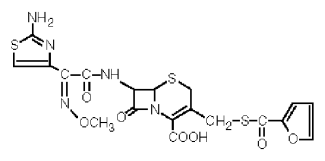
Chemical name of ceftiofur crystalline free acid:
7-[[2-(2-Amino-4-thiazolyl)-2-(methoxyimino)acetyl]amino]- 3-[[(2-furanylcarbonyl)thio] methyl]-8-oxo-5-thia-1- azabicyclo[4.2.0]oct-2-ene 2-carboxylic acid
Excede Sterile Suspension Indication
EXCEDE Sterile Suspension is indicated for the treatment of lower respiratory tract infections in horses caused by susceptible strains of Streptococcus equi ssp. zooepidemicus.
Excede Sterile Suspension Dosage And Administration
Shake well before using.
Administer two intramuscular injections to horses, 4 days apart, at a dose of 3.0 mg/lb (6.6 mg/kg). A maximum of 20 mL per injection site may be administered. Therapeutic drug concentrations are maintained for 6 days after the second injection (or a total of 10 days from the beginning of treatment) against Streptococcus equi ssp. zooepidemicus.
Table 1. Dosing Schedule for EXCEDE Sterile Suspension.
|
Weight (lb) |
Dose Volume (mL) |
|
100 |
1.5 |
|
200 |
3.0 |
|
300 |
4.5 |
|
400 |
6.0 |
|
500 |
7.5 |
|
600 |
9.0 |
|
700 |
10.5 |
|
800 |
12.0 |
|
900 |
13.5 |
|
1000 |
15.0 |
|
1100 |
16.5 |
|
1200 |
18.0 |
|
1300 |
19.5 |
|
1400 |
21.0 |
|
1500 |
22.5 |
|
1600 |
24.0 |
|
1700 |
25.5 |
|
1800 |
27.0 |
|
1900 |
28.5 |
|
2000 |
30.0 |
Contraindications
EXCEDE Sterile Suspension is contraindicated in horses with known allergy to ceftiofur or to β-lactam (penicillins and cephalosporins) group antimicrobials. Due to the extended exposure in horses, based on the drug’s pharmacokinetic properties, adverse reactions may require prolonged care.
Warnings And Precautions
Do not use in horses intended for human consumption.
Human Safety Warnings
Not for use in humans. For use in animals only. Keep this and all drugs out of reach of children.
Consult a physician in case of accidental human exposure. Penicillins and cephalosporins can cause allergic reactions in sensitized individuals. Topical exposure to such antimicrobials, including ceftiofur, may elicit mild to severe allergic reactions in some individuals. Repeated or prolonged exposure may lead to sensitization. Avoid direct contact of the product with the skin, eyes, mouth and clothing. Sensitization of the skin may be avoided by wearing protective gloves. Persons with a known sensitivity to penicillin or cephalosporins should avoid exposure to this product. In the case of accidental eye exposure, flush with water for 15 minutes. In case of accidental skin exposure, wash with soap and water. Remove contaminated clothing. If allergic reaction occurs (e.g. skin rash, hives, difficult breathing) seek medical attention.
Animal Safety Warnings And Precautions
Immediate onset of seizures or collapse have been reported following Excede administration.
The injection of EXCEDE Sterile Suspension in the horse may cause firmness, swelling, sensitivity, and/or edema at the injection site.
Injection site reactions may be extensive and require veterinary care.
The administration of antimicrobials to horses under conditions of stress may be associated with acute diarrhea that can be fatal. If acute diarrhea is observed, additional doses of EXCEDE should not be administered and appropriate therapy should be initiated.
Due to the extended exposure in horses, based on the drug’s pharmacokinetic properties, adverse reactions may require prolonged care. EXCEDE is slowly eliminated from the body, with approximately 17 days needed to eliminate 97% of the dose from the body. Animals experiencing adverse reactions may need to be monitored for this duration of time.
The use of ceftiofur has not been evaluated in horses less than 4 months of age and in breeding, pregnant, or lactating horses. The long term effects on injection sites have not been evaluated.
(See Animal Safety and Post Approval Experience sections)
Antibacterial Warnings
Use of antibacterial drugs in the absence of a susceptible bacterial infection is unlikely to provide benefit to treated animals and may increase the risk of the development of drug-resistant bacteria.
Adverse Reactions
Pre-Approval Experience:
total of 373 horses of various breeds, ranging in age from 4 months to 20 years, were included in the field study safety analysis. Adverse reactions reported in horses treated with EXCEDE and the placebo control are summarized in Table 2.
Injection site swelling (edema) was reported in 10 of 278 (3.6%) EXCEDE-treated horses and 1 of 95 (1%) of the placebo-treated horses. Of the 10 EXCEDE-treated horses with injection site swelling, 8 horses had swellings of 4 cm or less in diameter, one horse had a 10 cm diameter swelling and one horse had injection site reactions to both injections measuring 25 x 12 cm each. The injection site reactions in EXCEDE treated horses resolved over 1 to 20 days.
At least one episode of diarrhea, loose, soft, or cowpie stools were observed in 25 of 278 (9%) of the EXCEDE-treated horses and 7 of 95 (7%) of the placebo-treated horses. The duration of episodes in EXCEDE-treated horses ranged from a single observation of loose stool to observations lasting 6 days. All cases were self-limiting and resolved with minimal (a single dose of loperamide) or no treatment.
Table 2. Number of Horses with Adverse Reactions During the Field Study with EXCEDE.
|
Adverse Reaction |
EXCEDE (n=278) |
Placebo (n=95) |
|
Diarrhea/Soft Stool |
25 (9%) |
7 (7%) |
|
Injection Site Swelling |
10 (4%) |
1 (1%) |
Post Approval Experience (2019):
The following adverse events are based on post-approval adverse drug experience reporting for Excede. Not all adverse events are reported to FDA/CVM. It is not always possible to reliably estimate the adverse event frequency or establish a causal relationship to product exposure using these data.
The following adverse events for horses are listed in decreasing order by system and decreasing order within system classes.
Injection site reactions: swelling, pain, inflammation, infection, necrosis, muscle stiffness, fibrosis, injection site stiffness/ reluctance to move, hair change, lameness, granuloma.
Systemic: fever, lethargy, edema at locations other than injection site, anorexia.
Gastrointestinal: colic, diarrhea.
Neurologic: ataxia, muscle tremor, seizure, loss of consciousness.
Immune (Allergic reactions): anaphylaxis, urticaria, allergic edema (face, face and neck, lip, or limb edema).
In some cases, death has been reported as an outcome of the adverse events listed above. Sudden death (within minutes), or the immediate onset of seizures or collapse, followed by death or euthanasia, have been reported.
To report suspected adverse events, for technical assistance or to obtain a copy of the Safety Data Sheet (SDS) contact Zoetis, Inc. at (888) 963-8471. For additional information about adverse drug experience reporting for animal drugs, contact FDA at 1-888-FDA-VETS or online at http://www.fda.gov/reportanimalae.
Clinical Pharmacology
Ceftiofur is a beta-lactam antibiotic from the cephalosporin class. Beta lactams exert their inhibitory effect by interfering with bacterial cell wall synthesis. This interference is primarily due to its covalent binding to the penicillin-binding proteins, which are essential for synthesis of the bacterial wall. Ceftiofur administered as either ceftiofur sodium (NAXCEL® Sterile Powder) or ceftiofur crystalline free acid (EXCEDE Sterile Suspension) is rapidly metabolized to desfuroylceftiofur, the primary metabolite with antimicrobial activity. Two intramuscular injections of EXCEDE Sterile Suspension at a dose of 6.6 mg/kg body weight in the horse provide concentrations of ceftiofur and desfuroylceftiofur related metabolites in plasma above the therapeutic target of 0.2 µg/mL for the entire 96 hour (4 day) dosing interval and for 6 days after the second injection (or a total of 10 days from the beginning of treatment) (see Figure 2 and Table 3).
Figure 2. Average plasma concentration of ceftiofur and desfuroylceftiofur related metabolites in horses following the intramuscular administration of either EXCEDE Sterile Suspension at a dose of 3.0 mg/lb (6.6 mg/kg) administered twice at a 96 hour interval or NAXCEL Sterile Powder at a dose of 1.0 mg/lb (2.2 mg/kg BW) once daily for 10 consecutive days.
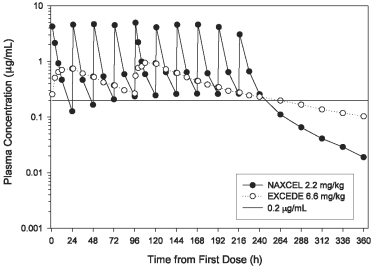
Table 3. Pharmacokinetic parameters measured after either two intramuscular injections of EXCEDE Sterile Suspension at a dose of 3.0 mg/lb (6.6 mg/kg) BW at a 96 hour interval or NAXCEL Sterile Powder at a dose of 1.0 mg/lb (2.2 mg/kg) BW once daily for 10 consecutive days are summarized in the following table.
|
PK Parameter |
CCFA-SS at 6.6 mg/kg BW administered twice 96 h apart (Mean ± SD; n=12) |
Ceftiofur sodium at 2.2 mg/kg BW once daily for 10 days (Mean ± SD; n=11) |
||
|
AUC 0-∞ (µg•h/mL) |
157 (19.1) |
353 (44.9) |
||
|
t>0.2 (h) |
262 (29.0) |
ND |
||
|
|
Dose 1 |
Dose 2 |
Dose 1 |
Dose 10 |
|
Tmax (h) |
21.6 (5.8) |
15.6 (6.3) |
1.0 |
2.0 (3.3) |
|
Cmax (µg/mL) |
0.78 (0.19) |
1.0 (0.24) |
4.31 ± 0.78 |
3.99 (1.23) |
Microbiology
Ceftiofur is a cephalosporin antibiotic. Like other ß-lactam antimicrobials, ceftiofur exerts its inhibitory effect by interfering with bacterial cell wall synthesis. This interference is primarily due to its covalent binding to the penicillin-binding proteins (PBPs) (i.e., transpeptidase and carboxypeptidase), which are essential for synthesis of the bacterial wall. Ceftiofur is not active against Pseudomonas spp. and enterococci.
The minimum inhibitory concentration (MIC) values for ceftiofur against label-claim pathogens isolated from lower respiratory tract infections in horses enrolled in a 2007-2008 field effectiveness study are presented in Table 4. All MICs were determined in accordance with the Clinical and Laboratory Standards Institute (CLSI) standards.
Table 4. Activity of EXCEDE Against Pathogens Isolated from Horses Treated With EXCEDE in Field Studies in the U.S. During 2007-2008.
|
Disease |
Pathogen |
Treatment Outcome |
# of Isolates |
Time of Sample Collection |
MIC50 µg/mL |
MIC90 µg/mL |
MIC Range µg/mL |
|
Lower Respiratory Tract Infection |
Streptococcus equi ssp. zooepidemicus |
Success |
93* |
Pre-Treatment |
0.06 |
0.12 |
0.03-0.5 |
|
Failure |
42 |
Pre-Treatment |
0.06 |
0.25 |
0.03-0.5 |
* One horse cultured Staphylococcus aureus (successfully treated) and is not represented in the table.
Effectiveness
A double masked, randomized, negative control, field study evaluated the effectiveness of two intramuscular doses of 6.6 mg/kg EXCEDE Sterile Suspension administered 4 days apart for the treatment of lower respiratory infections caused by Streptococcus equi ssp. zooepidemicus in the horse. In this study, a total of 278 horses were treated with EXCEDE, and 95 horses were treated with saline injections. One hundred ninety-three horses (136 EXCEDE and 57 saline placebo) were included in the statistical analysis. Therapeutic success was characterized by no worsening of clinical signs at Day 4, clinical improvement at Day 9, resolution of the clinical signs by Day 15, and no recurrence of clinical signs by Day 25 after initial dosing. EXCEDE was superior to the saline control. Table 5 summarizes the clinical success rates obtained 15 and 25 days after the first dose.
Table 5. Clinical success rates at Day 15 and 25.
|
Effectiveness parameter |
EXCEDE |
Saline Control |
P-value |
|
Clinical success Day 15 |
73.53% |
38.60% |
N/A |
|
Clinical success Day 25 |
69.12% |
31.58% |
0.0215 |
Animal Safety
Two studies, a target animal safety (TAS) study and a pharmacokinetic (PK) study (see CLINICAL PHARMACOLOGY section), were conducted to assess the safety of EXCEDE in the horse.
In the TAS study, healthy adult horses received 6 intramuscular (lateral neck) injections of EXCEDE Sterile Suspension at doses of either 3.0 (1X), 6.0 (2X) or 9.0 (3X) mg/lb with a 4 day interval between each injection. In the TAS study, there were no treatment related gastrointestinal findings for the three EXCEDE Sterile Suspension treatment groups. In the PK study, one horse treated with 6.0 mg/lb (2X) EXCEDE experienced a mild episode of colic the day after the second injection of EXCEDE. The horse recovered without treatment.
Injection sites were observed in both studies. In both studies, the largest injection volume administered was 20 mL per injection site. There were no observations of erythema, necrosis or drainage at the injection sites in these studies. Firmness, swelling, and/or sensitivity were observed in at least one injection site in all horses treated at the label dose. In the TAS study, injection site reaction measurements ranged from no measurable reaction to 16 x 33 x 1.5 cm. In the PK study, the largest area of edema associated with the injection site ranged from no detectable reaction to a 30 x 36 cm area of edema. Injection site reactions developed within 2 days of injection and resolved within 1-18 days. In the PK study, 2 horses had small areas of firmness that had not resolved at the end of the study (21 days after injection). In both studies, a greater incidence of injection site reactions occurred after the second injection, and in several horses, swelling at the injection site resolved then recurred 1-5 days later.
In the PK study, several horses developed clinical signs consistent with foot pain (stiff in the front limbs when turned in tight circles, and increased pulses and heat to the front feet). One horse in the NAXCEL group and one horse in the 6.0 mg/lb (2X) EXCEDE group were euthanized due to laminitis. Clinical signs of foot pain (stiff front limbs and increased heat and pulses in feet) affected more horses, for a longer period of time, in all EXCEDE-treated groups as compared to the NAXCEL-treated group. The study housing (multi-horse pens on concrete slabs) and diet (free choice alfalfa/grass mix and once a day pellets) may have contributed to the development of foot pain. The prevalence and severity of injection site reactions in EXCEDE-treated horses may also have contributed to the development of a stiff gait. A causal relationship between ceftiofur and foot pain could not be definitively determined.
Storage Conditions
Store at controlled room temperature 20° to 25°C (68° to 77°F). Shake well before using. Contents should be used within 12 weeks after the first dose is removed.
How Supplied
EXCEDE Sterile Suspension is available in the following package sizes:
100 mL vial
250 mL vial
Approved by FDA under NADA # 141-209
Distributed by: Zoetis Inc., Kalamazoo, MI 49007
www.EXCEDE.com or call 1-888-963-8471
Revised: January 2020
40029632
CPN: 3690484.2
333 PORTAGE STREET, KALAMAZOO, MI, 49007
| Telephone: | 269-359-4414 | |
| Customer Service: | 888-963-8471 | |
| Website: | www.zoetis.com |
 |
THIS SERVICE AND DATA ARE PROVIDED "AS IS". DVMetrics assumes no liability, and each user assumes full risk, responsibility, and liability, related to its use of the DVMetrics service and data. See the Terms of Use for further details. |

Copyright © 2025 Animalytix LLC. Updated: 2025-05-29
